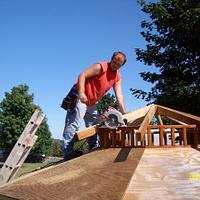
MontyJ
in over 11 years
Breadboard ends
I have a question about breadboard ends and the drawboard method. If one purpose of the breadboard end is to help stabilize the table top, yet allow for expansion, wouldn’t the drawboard method defeat the purpose by pulling the breadboard too tight against the top? Or am I not understanding something here?
Where are the band-aids?---Pro Libertate!
6 Replies
I’m eager to read the replies to this. Breadboards seem like a clever idea but I’ve always found the connection of them to be a bit counter-intuitive. I hope to learn…as always…the theories behind the process.
-- Alec (Friends call me Wolf, no idea why)
My understanding of the breadboard ends is that the tight hole for the drawbored peg is only in the center mortise of the breadboard end. Other mortises have elongated holes that allow for expansion and contraction of the top. Also the mortises that are not centered in the breadboard end have extra space for the tenons to move side-to-side with expansion and contraction of the top. The drawboring keeps the end tight to the top but allows the top to expand and contract.
I just watched one of those woodworking shows on pbs the other day about this. The guy cut the tenons narrow so there was space between them. He really didn’t go into the why – or maybe I just missed it – but that makes sense in a movement situation. He did mention that he cut the breadboard slightly larger than the width of the table top because it was winter when he filmed it and he was prepared for expansion. He said cut it the same width in the summer because the top will have already expanded to it’s maximum size.
Losing fingers since 1969
PS: It looked like there was about 1" to 1-1/2" between the tenons.
Losing fingers since 1969
3 demerits for improper use of the term “drawbore”.
The drawbore pins, if installed correctly, do indeed tighten the mortise and tenon joint. But since the pins are the only point of connection, the wood is still able to move within the mortise. Glue on the other hand indiscriminately locks the tenon within the mortise which leads to expansion cracks.
Artisan Woodworks of Texas- www.awwtx.com
Dammit, three demerits! How am I going to make that up?? And how many do I have before I lose my shop card? Did I mention I used hand-cut dovetails in a drawer and after several days they still haven’t came apart? Do I get credit for that?
My concern with the drawbore technique was that it seems to cause drag between the edges of the breadboard and the table top. I suppose since it’s done all the time, it must be OK.
I can now safely check this one off my stupid question list. But, have no fear; there’s plenty more where that came from ;)
Where are the band-aids?---Pro Libertate!












